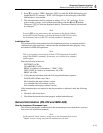
2620A, 2625A
Users Manual
4-8
To connect the instrument to a specific brand of RS-232 printer, use the cable that would
be used to connect that printer to an RS-232 port on an IBM PC/AT (DB-9 connector).
The RS42 cable is compatible with most serial printers; contact Fluke for printer
compatibility information.
Once the cable is connected, turn the instrument back on. You are now ready to operate
the instrument over the RS-232 interface.
Installation Test
The procedure below demonstrates the instrument processing a computer interface
command and, at the same time, confirms that the instrument has been properly set up
and cabled for computer interface operations:
1. Ask for the instrument identification by sending the following query:
*IDN? <CR>
2. Verify that the instrument sends either of the following responses:
FLUKE,2620A,0,Mn.n An.n Dn.n
=>
FLUKE,2625A,0,Mn.n An.n Dn.n
=>
Mn.n identifies the main software version.
An.n identifies the A/D software version.
Dn.n identifies the display software version.
The RS-232 prompt => means that the command has been executed and the
instrument is ready to accept another command.
RS-232 Information
Character Echoing
With the RS-232 interface, characters sent to the instrument can be automatically echoed
back to the host. When Echo is set "On", characters sent to the instrument are echoed
back to the host. With Echo "OFF", characters are not echoed back. To set the Echo
parameter, refer to the procedure earlier in this chapter under "Setting Communication
Parameters (RS-232)".
Character Deletion
Characters sent directly from a host to the instrument can be deleted by pressing the
<DELETE> or <BACKSPACE> key. Backspaces are echoed to the host if Echo is "On".
Device Clear Using Ctrl C
CTRL C is the RS-232 equivalent of IEEE-488 DC1 (device clear), causing the output
sequence:
=> <CR> carriage return <LF> line feed.
Use of CTRL C clears the RS-232 input buffer.


















